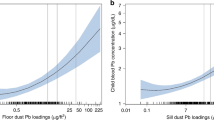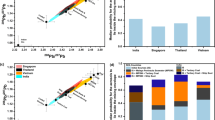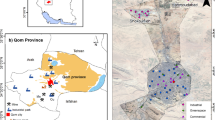Abstract
LEAD pollution and its effects on health are matters of general concern1,2. The potential danger to children is now receiving particular attention. Lead in various inorganic forms may be inhaled or ingested, and various sources of ingested lead (for example food, tapwater, paint) are recognised, and tolerable limits have been established. Recently, it was claimed2 that for children in urban surroundings the dust of streets and playgrounds is a potentially significant source of lead, and that the lead in such dust can be over 1,000 p.p.m. (0.1%). This is a source of lead which is not immediately controllable, but we consider that its importance as a component of the lead intake of urban children has not been sufficiently assessed.
This is a preview of subscription content, access via your institution
Access options
Subscribe to this journal
Receive 51 print issues and online access
$199.00 per year
only $3.90 per issue
Buy this article
- Purchase on Springer Link
- Instant access to full article PDF
Prices may be subject to local taxes which are calculated during checkout
Similar content being viewed by others
References
Chow, T. J., Chemy. Br., 9, 258–263 (1973).
Public safety: lead, Which?, 104–111 (Consumers' Association, London, April 1973).
Branquinho, C. L., thesis, Univ. Rio de Janeiro (1973).
Hunt, W. F., Pinkerton, C., McNulty, O., and Creason, J. P., in Trace Substances in Environmental Health, IV (edit. by Hemphill, D. D.) (Univ. Missouri Press, Columbia, 1971).
Schroeder, H. A., and Tipton, I. H., Archs envir. Hlth, 17, 965–978 (1968).
Booker, D. V., Chamberlain, A. C., Newton, D., and Scott, A. N. B., Br. J. Radiol., 42, 457–466 (1969).
King, B. G., Am. J. Dis. Child., 122, 337–340 (1971).
Survey of lead in food (HMSO, London, 1972).
Proudfit, F. T., and Robinson, C. H., Normal and Therapeutic Nutrition, twelfth ed., (Macmillan, London, 1961).
Recommendation of the 16th Joint FAO/WHO Expert Committee on Food Additives (WHO, Geneva, 1972).
Moncrief, A. A., and Koumides, O. P., Archs Dis. Childh., 39, 1–18 (1964).
Author information
Authors and Affiliations
Rights and permissions
About this article
Cite this article
DAY, J., HART, M. & ROBINSON, M. Lead in urban street dust. Nature 253, 343–345 (1975). https://doi.org/10.1038/253343a0
Received:
Revised:
Issue Date:
DOI: https://doi.org/10.1038/253343a0
Comments
By submitting a comment you agree to abide by our Terms and Community Guidelines. If you find something abusive or that does not comply with our terms or guidelines please flag it as inappropriate.



